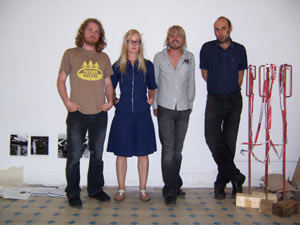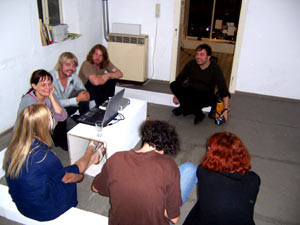Am Freitag den 3. September ab 19 h ist das Kollektiv C.CRED (Kollektiv
kreativen Dissenses) in der Oberwelt zu Besuch und sucht eher weniger
formell den Austausch mit einer interessierten Öffentlichkeit.
Die Londoner Gruppe ist aktuell auf der Durchreise von Litauen und wird
in Stammheim ein Monument oder Anti-Monument installieren. Das Bündnis
von Künstlern, Historikern, Theoretikern und Aktivisten hat zur
Geschichte des Gefängnisses recherchiert und ein Archiv aufgebaut.
Insgesamt geht es C.CRED laut Manifest darum, eine Experimentierzone
zu etablieren, in der disparate Elemente der Suche nach neuen Formen
einer Praxis zusammengebracht werden können. Kollektive künstlerische
und politische Produktion, Ausdruck und Intervention zielen auf eine
unmittelbare kulturelle, künstlerische und sozio-politische Präsenz.
Die lose Gemeinschaft sucht explizit nach Bündnissen mit anderen
Gruppen und Kollektiven, um über E-Mail zu weiteren Bündnis-Strukturen
zu kommen und die Grundlage für Netzwerke zu legen.
In dem Projekt Counter/Cartographies z.B. hat C.CRED damit begonnen,
eine Serie von Karten herzustellen, von Künstlern, Aktivisten,
Kollaborativen Zusammenhängen, Gruppen und Kollektiven, die mit
verschiedenen Ansätzen und Ideen von Widerstand und sozialem Engagement
arbeiten.
Weitere Informationen zu C.CRED unter www.ccred.org
Fragen zum Oberwelt-Gesprächsabend:
1. Zur Form des Monuments in zeitgenössischer Kunstpraxis:- - Wie beziehen wir uns als Künstler auf Geschichte und arbeiten mit ihr?
- - Welche Bedeutung hat historisch-politisches Bewusstsein in einer künstlerischen Praxis?
- - Was ist präzise die Funktion eines Monuments in historischer, Hinsicht aber auch in Hinsicht auf öffentlichen Raum im Sinne einer Anordnung von Machtbeziehung?
- - Gibt es einen Raum oder eine Praxis von Gegen-Monumentalisierung, eines Gegen-Monumentes?
2. Zur (diskursiven) Geschichte des Legal-politischen Begriffs von Terrorismus in Beziehung zum Potenzial militanter Praxis als eine Form politischen Ausdrucks:
- - Was ist die Geschichte des legalen Begriffs Terrorismus und wie bezieht er sich auf Modernität und die Entwicklung internationalen /globalen Kapitalismus?
- - Wie willkürlich ist er als Definition?
- - Welche Rolle spielt er bei der Entwicklung internationaler Verträge, Kartographien usw.?
- - Welche Arten verschiedener Praxis deutet er an?
- - Welche Formen politischer Unterscheidung können wir zwischen diesen verschiedenen Ansätzen machen?
3.Zur Geschichte `militanter´ Praxis und speziell zur ersten Generation der RAF und der Situation in Stammheim:
- - Gibt es etwas, das aus der militanten Praxis übernommen werden kann?
- - Gibt es einen Begriff (oder eine Konzeption) des Terroristischen, der (die) aus den verschiedenen Diskursen entwickelt werden kann und in den (die) diese Praxis eingeschrieben ist und der (die) als, zumindest bis zu einem gewissen Ausmaß, ethisch (i.S. Spinozas) oder ästhetisch (i.S. des Experiments) produktiver Weg bestätigt wird?

